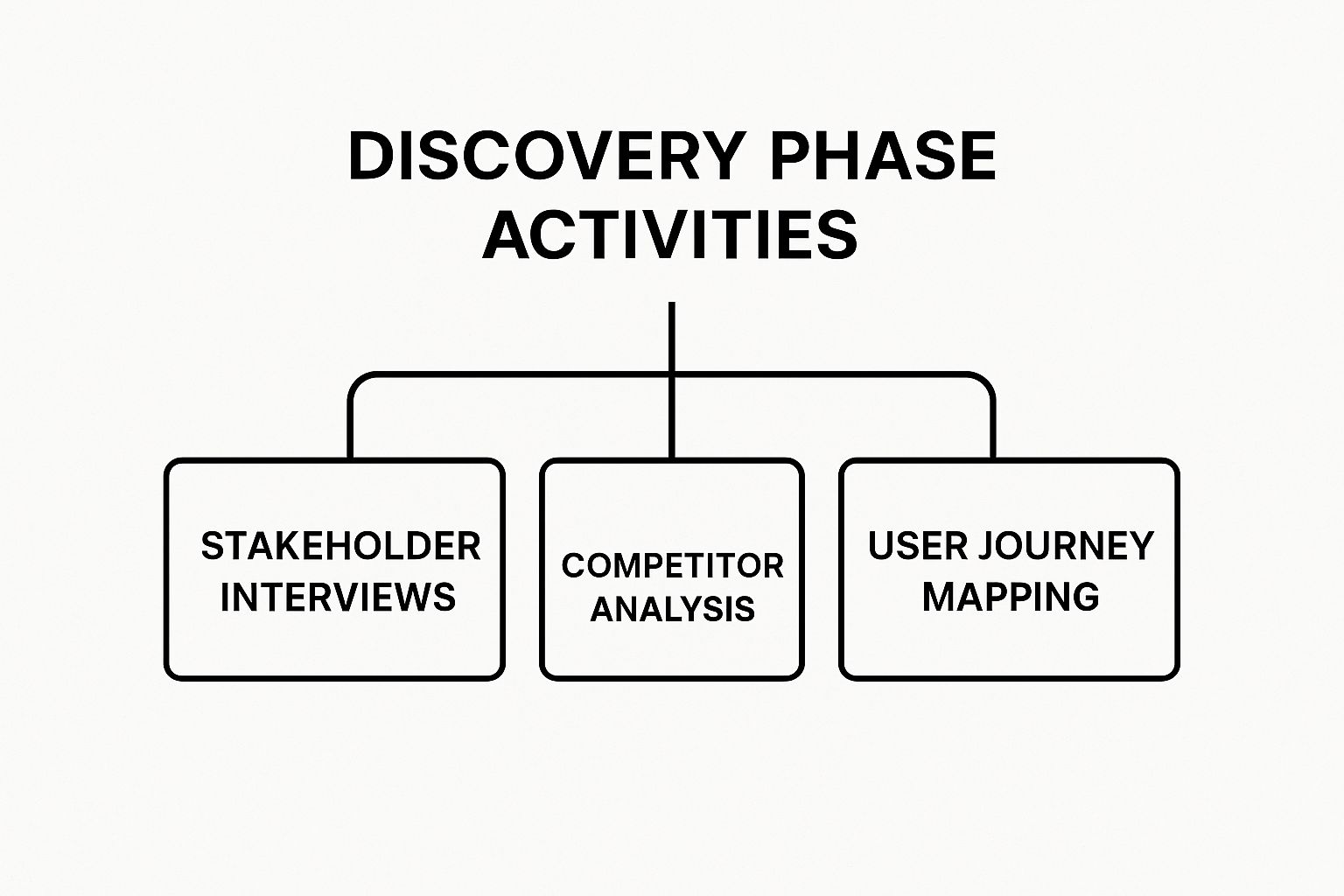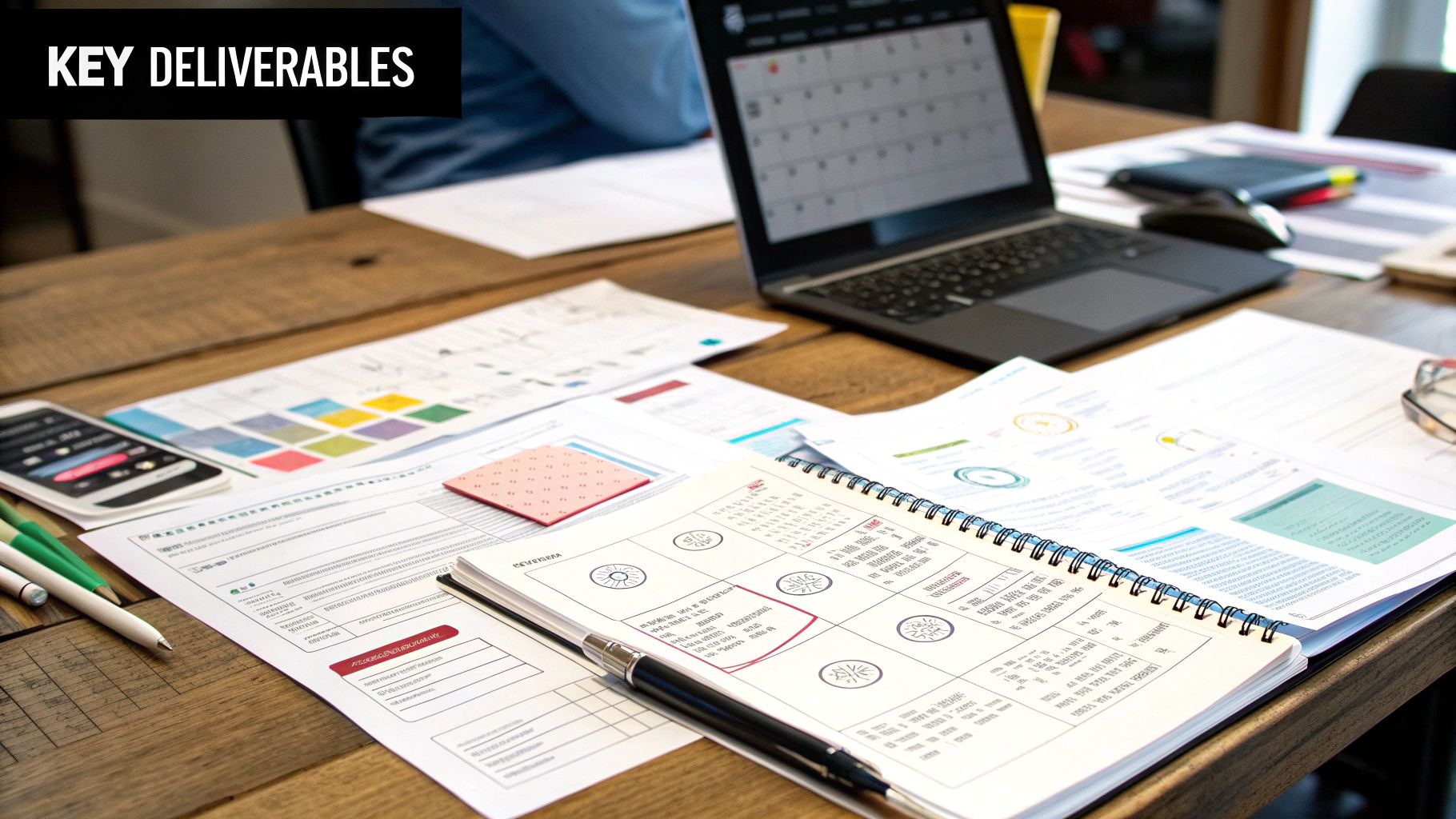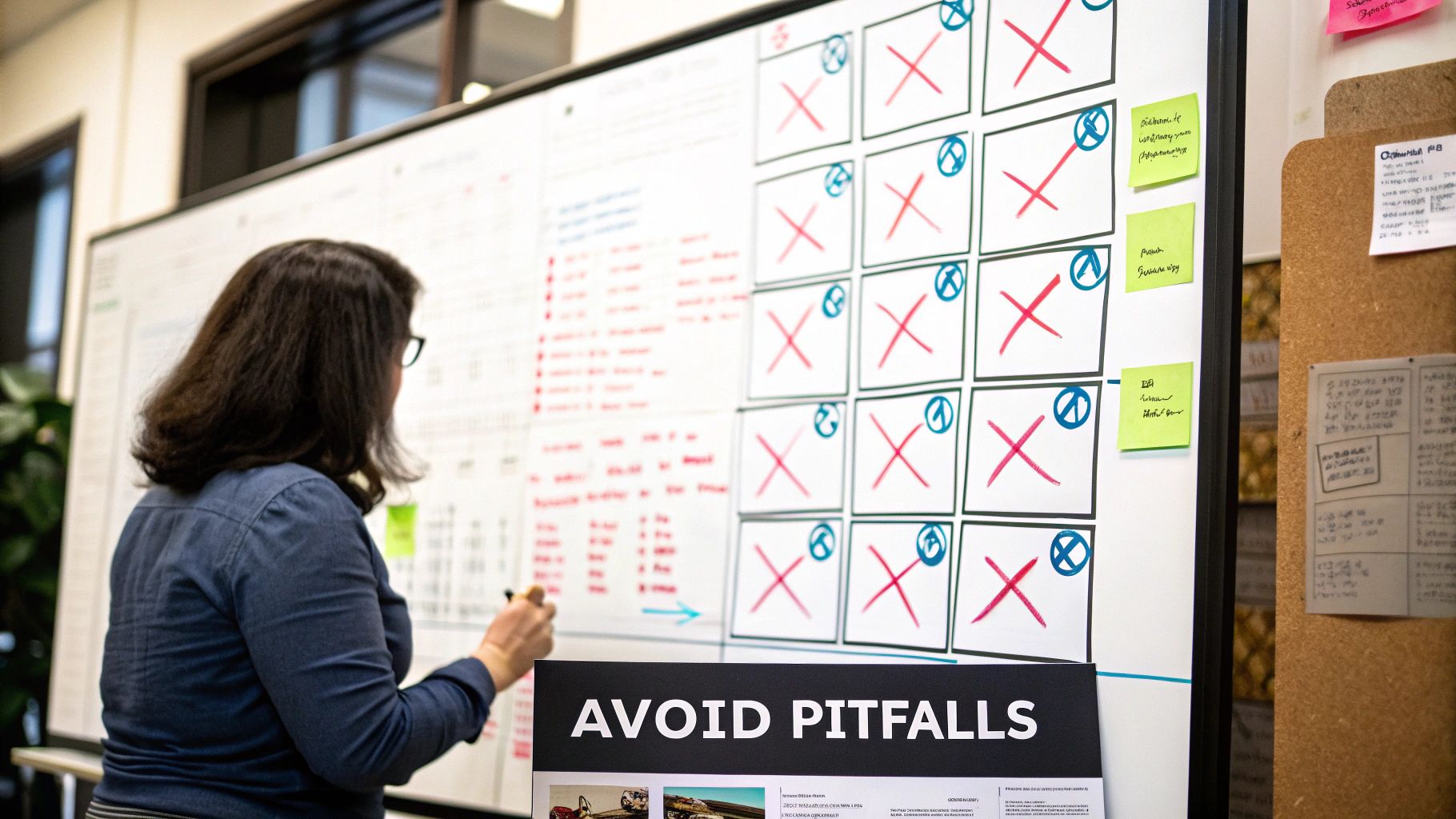A Guide to the Discovery Phase Project
Unlock project success with our guide to the discovery phase project. Learn the key steps, deliverables, and strategies to build a solid foundation.

Jumping into a software project without a discovery phase is like trying to build a house without a blueprint. Sure, you can start nailing boards together, but you’ll probably end up with something that's unstable, over budget, and doesn't look anything like what you imagined. This initial phase is your blueprint—it’s where you do the critical thinking upfront to prevent costly rework later.
A discovery phase project is essentially a deep-dive investigation. It’s a structured process that happens before any real development begins, aimed at mapping out the project's goals, scope, potential risks, and what users actually need.
What Is a Project Discovery Phase

Think of the discovery phase as setting your project’s GPS. Without it, you’re just driving blind. It’s the formal process of gathering all the essential information to align everyone’s expectations and kill any ambiguity before a single line of code gets written.
This isn't just a 30-minute kickoff call. It’s an intensive, collaborative effort to get to the heart of the project. We’re talking about validating the core business idea, making sure it’s technically possible, and really digging into the "why," "what," and "how." The whole point is to ensure the final product actually solves a real problem for real people.
The Foundation for Success
The number one goal here is to get everyone—from the CEO to the developers—on the exact same page. This shared understanding is the bedrock of a successful project. When everyone is aligned, you sidestep major issues like "scope creep," that frustrating cycle where new features keep getting tacked on, derailing the budget and timeline.
A properly run discovery phase project pays for itself almost immediately. Here’s why:
- Clarity on Project Scope: You get a crystal-clear picture of what will be built and, just as crucially, what won't.
- Risk Mitigation: You spot potential landmines early—whether they're technical challenges, market risks, or resource gaps—and plan around them.
- Accurate Budgeting and Timelines: Once the scope is locked in, you can create cost estimates and delivery schedules that you can actually trust.
- Stakeholder Alignment: It unifies the entire team and all stakeholders around a single, clear vision.
The discovery phase is the single most effective way to prevent project failure. It’s a known fact in the industry: mistakes made during initial planning are the most expensive and painful to fix down the road. This upfront investment is invaluable.
Ultimately, this process turns a fuzzy idea into a concrete, actionable plan. It’s a critical first step that guides the entire project, fitting into the larger framework of a well-run enterprise software development process. By taking the time to plan and research upfront, you lay a solid foundation that will support your project all the way to a successful launch.
What Are We Trying to Accomplish in a Discovery Phase?
Before a single line of code gets written, a discovery phase sets the stage for everything that follows. Think of it as creating the North Star for your project. These goals aren't just a checklist; they're the fundamental "why" behind every decision, making sure the final product doesn't just work, but actually succeeds.
The main point is to get everyone on the same page, creating one unified vision for the project. You need every single stakeholder—from the CEO to the junior developer—to see the exact same finish line. This avoids that all-too-common nightmare where different teams have totally different ideas of what's being built, leading to chaos and expensive fixes later.
Getting Everyone on the Same Page
The first, and maybe biggest, challenge is creating that shared understanding. A good discovery phase uses structured workshops and deep-dive interviews to pull those fuzzy ideas out of people's heads and turn them into concrete, agreed-upon goals. It’s all about making sure everyone knows what "success" actually means, both for the business and for the end-user.
For instance, your marketing team might see success as a sky-high conversion rate. But your engineering team is probably focused on rock-solid system stability. The discovery phase is where you blend those views into a single strategy: a stable, easy-to-use platform that naturally leads to great conversions.
Nailing Down a Clear Project Scope
Once everyone is nodding in agreement, the next goal is to define the project scope—and make it airtight. This means getting super specific about what the product will do and, just as crucially, what it won't do. This clarity is your single best defense against scope creep, that sneaky expansion of features that can derail your timeline and blow your budget.
A big part of this is figuring out the scope of your first release, often called a Minimum Viable Product (MVP). An MVP has just enough core features to attract early users and gather feedback to guide future development. It's a critical concept to grasp, and you can get the full story by reading What Is a Minimum Viable Product.
A well-defined scope document is like a contract between the project team and the stakeholders. It becomes the official rulebook everyone can refer back to when new ideas pop up, keeping the team focused on delivering what was originally promised.
Spotting Risks and Proving the Idea Has Legs
Another key job of discovery is to be the project's early-warning system. By digging into technical needs, market trends, and potential user roadblocks, the team can spot risks long before they become full-blown crises. A little proactive thinking here saves a ton of time and money down the road.
At the same time, discovery is where you validate the business idea itself. You're trying to answer the most important question of all: Is there a real audience with a real problem that this product can solve? User research and competitor analysis help confirm that you're not just building a beautiful solution to a problem nobody actually has.
The discovery phase usually takes up about 5-10% of the total project budget, but the return on that investment is huge. This upfront work creates a financial blueprint, laying out all the technical needs so you can estimate costs accurately. Skip this step, and you're almost guaranteed to run into surprise expenses and painful, time-sucking changes later on. You can find more on this at mirumee.com.
What Happens During a Project Discovery Phase?
A successful discovery phase isn't just a series of random meetings; it's a carefully coordinated investigation. Think of it like a detective story where a team of specialists works together, each with a specific role, to piece together clues, test theories, and build a rock-solid case for the project.
It all starts with human-to-human conversations to understand the big picture. From there, the process moves into market analysis, getting inside the heads of users, and finally, a reality check on what's technically possible. Every step logically flows into the next, systematically turning a fuzzy idea into a clear, actionable plan.
The following diagram shows how these core activities fit together, starting with high-level stakeholder input and branching out to explore the market and user needs.

As you can see, discovery isn't a single path. It's about exploring business goals, the competitive landscape, and user desires all at once to get a complete picture.
Core Discovery Activities Unpacked
So, what does the team actually do? Let's break down the essential activities. These aren't just items on a checklist; they're deep dives that require focus and expertise to get right. When done correctly, they strip away risk and ensure the final product hits the mark for both the business and its users.
- Stakeholder Interviews: This is where it all begins. The team sits down with everyone who has a stake in the project—from C-suite executives to the subject matter experts on the ground. The goal is to nail down the business vision, agree on what success looks like, and understand any limitations from the get-go.
- Competitor Analysis: No product exists in a vacuum. During discovery, teams of project managers, architects, designers, and developers conduct intense competitor research and market analysis to find gaps and opportunities. They look at everything from business models and pricing to specific features, figuring out how the new product can stand out. This in-depth analysis shapes a project's direction more than almost any other activity.
- User Journey Mapping: Next, the spotlight turns to the end-user. The team creates visual maps of every single interaction a user has with the product. This process is fantastic for spotting pain points, moments of frustration, and clear opportunities to make their lives easier.
- Technical Feasibility Study: This is where the rubber meets the road. The tech team takes the proposed features and rigorously investigates whether they can actually be built with the available technology, budget, and timeline. It’s a crucial step that stops teams from promising the moon and failing to deliver.
The Key Players and Their Contributions
A discovery phase is a team sport, not a solo mission. It needs a dedicated, cross-functional group where each person brings a unique lens to the problem. This mix of perspectives—business, user, and technical—is what ensures every angle is covered.
The real magic of a discovery team is its diversity. A Business Analyst, a UX Designer, and a Technical Lead will all look at the same problem and see completely different things. That 360-degree view is what uncovers true innovation and prevents costly blind spots down the road.
To make it clear who does what, let's look at the essential roles and what they bring to the table.
Key Team Roles and Responsibilities
This table breaks down the core team members you'll find in nearly every discovery phase and outlines their primary focus.
| Role | Primary Responsibility | Key Activities |
|---|---|---|
| Project Manager | Keeps the discovery process on track, on time, and on budget. | Schedules workshops, facilitates meetings, documents decisions, and ensures everyone hits their deadlines. |
| Business Analyst | Acts as the bridge between business goals and project requirements. | Conducts stakeholder interviews, performs market/competitor analysis, and defines the project's scope. |
| UX/UI Designer | Serves as the voice of the user. | Creates user personas, maps out customer journeys, builds wireframes, and develops simple prototypes for testing. |
| Technical Lead | Determines what's technically possible and how to build it. | Evaluates existing systems, researches tech stacks, identifies technical risks, and provides early development estimates. |
When you bring these distinct roles together, the project discovery phase becomes far more than just a fact-finding mission. It evolves into a powerful strategic planning process that ensures the final plan is ambitious yet realistic, user-focused, and technically sound.
The Essential Deliverables Your Project Needs

A great discovery phase project isn't just about good conversations and brainstorming sessions. It's about producing concrete documents that become the DNA of your project. These deliverables turn abstract ideas into a shared plan, making sure everyone is rowing in the same direction.
Without this documentation, you're flying blind. You risk confusion, misalignment, and the kind of expensive rework that sinks projects. These artifacts are your best defense against ambiguity, giving your team the clarity it needs to make smart design, development, and strategic decisions.
Let's look at what you should walk away with.
The Project's North Star
First up is the Vision and Scope Document. Think of this as your project’s constitution. It lays out the "what" and the "why" in plain language, defining the business goals, the problems you're solving, and the big-picture vision for the final product.
More importantly, it draws a line in the sand by detailing what’s out of scope. This is your secret weapon against scope creep, stopping the project from getting bloated with features that weren't part of the original plan.
Right alongside it is the Software Requirements Specification (SRS). If the vision doc is the strategy, the SRS is the tactical plan. It gets into the nitty-gritty, providing a detailed breakdown of all the functional and non-functional requirements. It becomes the single source of truth for the development team.
Bringing the User to Life
To build something people actually want to use, you have to know who they are. This is where we shift from business goals to human needs.
- User Personas: These are detailed profiles of your ideal users, built from real research. They’re not just about demographics; they capture motivations, goals, and frustrations, helping the entire team build with a real person in mind.
- Customer Journey Maps: This is a visual story of a user's entire interaction with your product, from the moment they hear about it to completing a key task. It’s fantastic for spotting where things are going well and where users are getting stuck.
- User Stories: These are simple, bite-sized descriptions of a feature from the user’s point of view. For a deeper look at getting these right, check out our guide on writing user stories.
These user-focused documents are the bridge between technical specs and a genuinely helpful product. They ensure the team never forgets they’re solving a real problem for a real person.
Visualizing the Solution and the Path Forward
Okay, you know the problem and you know the user. Now it's time to start sketching out the solution and mapping the road ahead. This is where ideas start to feel real.
Low-Fidelity Prototypes and Wireframes are the first visual step. They are simple, black-and-white layouts that focus entirely on structure, flow, and function. By leaving out colors and branding, you can get honest feedback on the core user experience without anyone getting distracted. It’s a cheap and incredibly effective way to test ideas early.
Finally, all of this information funnels into the Preliminary Project Roadmap. This is your high-level timeline, outlining the major milestones, development sprints, and estimated delivery dates. It gives everyone a clear view of the path forward, helping stakeholders manage expectations on timing and costs.
These documents don't just sit on a shelf. They are essential inputs for the next phase, especially when you're creating a product roadmap for the long haul. Each deliverable builds on the last, creating a solid blueprint that cuts down on risk and sets your project up for success.
How Discovery Prevents Project Failure
We've talked about the theory, but where the discovery phase really shines is in the real world. It’s not just another meeting or a box to check off. A proper discovery is often the one thing that separates a runaway success from a product nobody wants.
Think of it as a small investment that pays off big time. By spending a little time and money upfront, you can avoid expensive rewrites, find a better market fit for your product, and even stumble upon money-making ideas you never would have seen otherwise.
Uncovering Hidden Opportunities
Let’s look at a real-world scenario. An e-commerce startup was ready to build a new mobile app. The plan was straightforward: include the usual payment options like credit cards and PayPal. Simple enough.
But during discovery, the UX team started talking to actual potential customers. And a clear pattern popped up. A lot of people were fed up with the standard payment process and really wanted a "buy now, pay later" option.
That insight was a total game-changer. The team shifted gears and made that feature the star of the show.
When the app launched, that one feature became their biggest competitive advantage. It drove a ton of sign-ups and helped them stand out in a really crowded market. Without that discovery phase, they would’ve just been another generic app, completely missing their best shot at success.
Navigating Complex Roadblocks Early
Here’s another example. A fintech company was building a big, ambitious investment platform. The initial idea looked great on paper—sleek and easy to use. But the discovery phase quickly revealed a minefield of regulatory headaches the original stakeholders hadn't fully thought through.
The business analysts and tech leads dug in, spending weeks mapping out all the compliance rules for different countries. They spotted legal traps that could have led to huge fines or even forced a complete do-over if they'd been found after coding had already started.
A discovery phase is your project's early warning system. Finding a critical regulatory issue or a technical dead-end before you've written a single line of code is priceless. It saves you more than just money—it saves you months of wasted work.
Finding these problems early meant the team could adjust their plans, build compliance in from the very beginning, and dodge a disastrous launch. A big part of this is anticipating what could go wrong. You can get a better handle on this in our guide to software development risk management.
Time and again, we see discovery completely change a product for the better. One team building a business services marketplace talked to their target users and realized they were on the wrong track. They pivoted from a simple info aggregator to a platform that focused on what users actually needed when requesting information. That simple shift made their product incredibly relevant and a much better fit for the market. These stories prove that discovery is absolutely essential for making sure your product meets real user needs and hits your business goals.
Common Mistakes to Avoid During Discovery

Even the most seasoned teams can stumble during a discovery phase project if they aren't careful. Think of this initial stage as laying the foundation for a skyscraper—get it right, and you have a solid base for success. Get it wrong, and the entire project can come crashing down.
One of the most tempting mistakes is simply rushing through it. Everyone's excited to start building, so discovery gets treated like a box-checking exercise. This is a huge mistake. Skipping or shortening discovery almost guarantees you'll face expensive rework, overlooked requirements, and a product that ultimately misses the mark with users.
Another classic blunder? Not having the right people in the room from the start. If you leave out key stakeholders, you're missing huge pieces of the puzzle. This creates a lopsided vision built on incomplete information, which is a perfect recipe for conflict and massive scope changes later on.
Overlooking Technical Realities
A brilliant idea is just a dream if you can't actually build it. One of the biggest traps teams fall into is neglecting the technical feasibility assessment. They get so attached to a concept that they forget to check if it's even possible with the available budget, timeline, and technology.
This is where your technical experts are your best friends. They can see the hidden icebergs—like tricky third-party integrations or potential performance issues—long before a single line of code is written. Without that technical reality check, you could end up designing a product that's impossible to build or one that requires a massive, unplanned budget to even get off the ground.
"Mistakes made during the planning stage are the most expensive to fix later. Overlooking technical feasibility isn't just a risk; it's a guarantee of future headaches, budget overruns, and delayed timelines."
Falling for Internal Biases
Every company has its own "common knowledge" about what customers want. The problem is, these assumptions are often just that—assumptions. A core purpose of the discovery phase project is to put those internal beliefs to the test with cold, hard facts.
You have to let objective evidence guide you, not just gut feelings from the boardroom. Here’s how you can stay grounded in reality:
- Conduct User Interviews: Go talk to real, potential customers. Find out what their actual problems and needs are, straight from the source.
- Analyze Competitors: Look at what others in your space are doing well, but more importantly, find the gaps they're leaving for you to fill.
- Use Data: Dive into market trends and analytics to make sure your strategic decisions are based on data, not just opinions.
Finally, don't let yourself get away with vague or incomplete documentation. When requirements are fuzzy, developers have no choice but to guess, and that guesswork rarely aligns with what stakeholders actually envisioned. Clear, detailed deliverables are the guideposts that keep everyone on the same page, preventing confusion and ensuring the final product truly delivers on its promise.
Got Questions About the Discovery Phase? We've Got Answers.
Even with a clear understanding of the goals and activities, practical questions always pop up. It's only natural. This is where we tackle the common "what ifs" and "how longs" that might still be on your mind.
Think of this as the final pre-flight check. Answering these questions now ensures everyone, from the project sponsor to the dev team, is buckled in and ready for a smooth takeoff.
How Long Should a Discovery Phase Take?
This is the big one, and the honest answer is, "it depends." The timeline for a discovery phase project is directly linked to how complex your final product will be. A straightforward mobile app might only need a focused two-week deep dive. On the other hand, a sprawling enterprise platform with tricky integrations could easily require a six-week investigation to get right.
I know, that can feel like a long time before a single line of code is written. But this upfront investment is what saves you from months of headaches, budget blowouts, and painful do-overs later. It’s the classic "measure twice, cut once" principle in action.
Remember, the time spent in discovery isn't a delay; it's an accelerator. It means that when development does start, the team can hit the ground running with total confidence and a shared vision.
Can We Skip Discovery for a Small Project?
It's tempting, isn't it? For a small project, it can feel like overkill. But even the tiniest projects benefit from what you might call a "discovery lite." The core ideas—getting everyone on the same page and spotting problems early—are just as important, no matter the scale.
You probably don't need a month of workshops for a small-scope project. But you absolutely need to:
- Confirm the goal: Does every single stakeholder agree on what "done" and "successful" look like?
- Define the scope: Get crystal clear on what's in and, just as importantly, what's out.
- Identify users: Who are you actually building this for? What do they truly need?
- Check feasibility: Do a quick gut check to make sure the technical plan makes sense.
Skipping these basic checks is like hopping in a car for a road trip without ever agreeing on the destination. It’s a surefire way to turn minor miscommunications into major roadblocks that wreck your timeline and budget.
How Is This Different from a Kickoff Meeting?
This is a great question because they sound similar but are worlds apart. A project kickoff is a one-time event, usually a meeting that lasts a couple of hours. Its job is to introduce the team and point everyone in the same general direction. It’s the starting gun for the race.
The discovery phase project, in contrast, is the entire training camp before the race even starts. It’s a deep, hands-on process involving research, analysis, talking to stakeholders, and building a solid strategic plan. The kickoff meeting is just one small part of it.
A kickoff gets the team aligned for a moment; discovery ensures they stay aligned for the entire journey.
At 42 Coffee Cups, we turn your validated ideas into high-performance web applications. Our expert teams specialize in Python/Django and Next.js to build scalable solutions that drive growth, helping you launch your MVP in under 90 days. Start your project with us today.